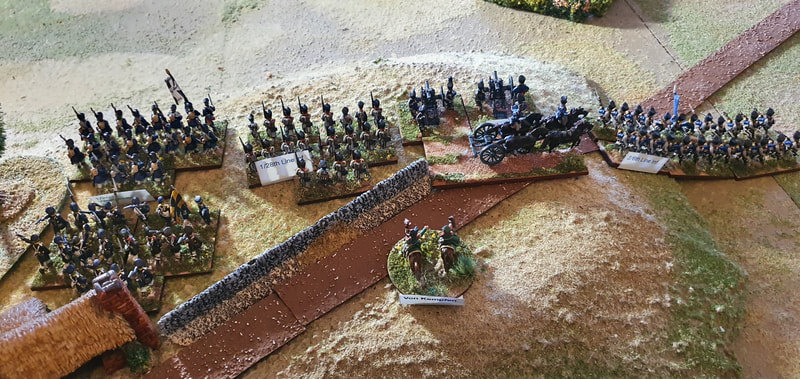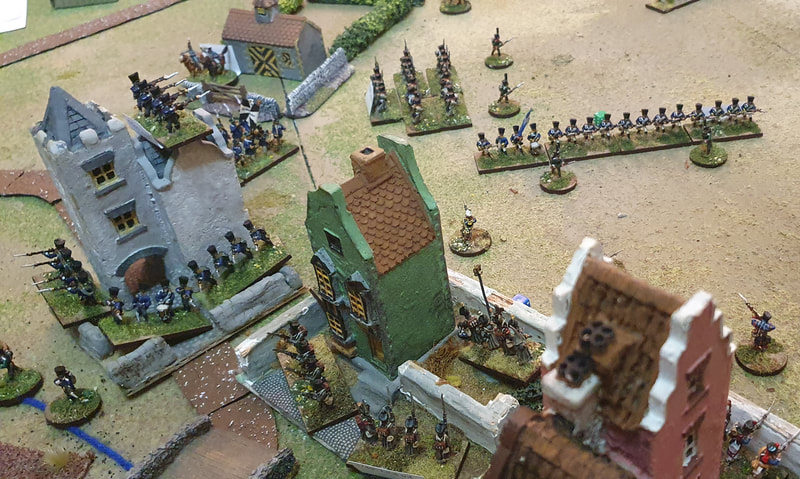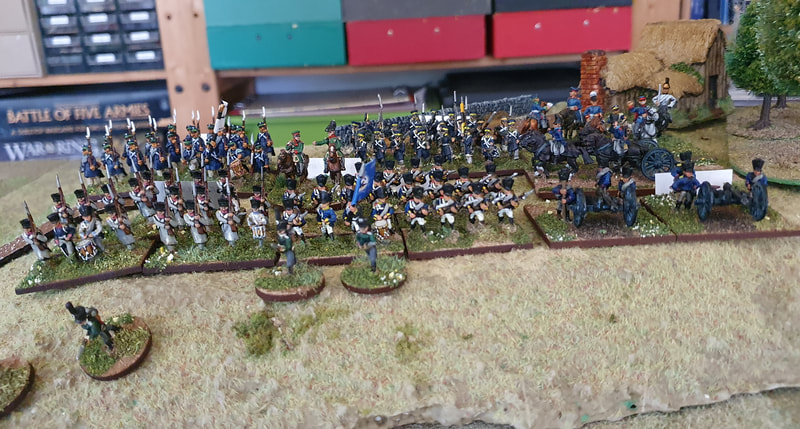|
On 10 September, my friend Keith came up from Devon to attend Colours at Newbury and then play a game of Soldiers of Napoleon. We played the Ligny scenario mentioned in my last blog post, on the Napoleonic scenarios page here. On 26 September, Dan, Spencer and I played the scenario again. They were both cracking games. Skip this bit if you already play SoNAs Soldiers of Napoleon (SoN) is still a new set, it might be worth summarising the way the rules work. The USP is the deck of cards, which regulate various aspects of play. The players start the turn with a hand of cards each, which they play alternately until both run out and the turn finishes. Each card can be played for one of three purposes: to issue orders to a variable number of units in one brigade; to rally all eligible units in a brigade; or to launch a special event. Of course, you can’t use a card for more than one purpose at a time so there are always tough choices to be made. Movement and shooting are both straightforward processes, in much the same mould as other Napoleonic rules. There are a couple of unusual orders that we really like: light cavalry can ‘harass’ enemy skirmishers, with the possible result that the skirmishers will fall back to rejoin their parent battalions. Heavy cavalry, meanwhile, can intimidate enemy by their very presence. I like it that your cavalry can influence the battle in more subtle ways than charging at the first target. The rally and stand removal mechanic is highly original and takes some getting used to. An important point to remember is that while every card has a Rally function, you can only rally troops of the quality levels specified on that card. Pretty much every card lets you rally elite and professional troops but very few cards allow you to rally militia. So if, like the Prussians in 1815, you have a lot of Landwehr militia in your army, make every card that can be used to rally militia count. Sadly, this will mean forgoing some neat special events and high digit orders, but your army will dissolve if you don’t rally your militia when you can. The Rally process involves different steps that it is important to follow in sequence. You can soak off disruption points in different ways including stand removal. While stand removal is seemingly voluntary, it is better to lose a stand or two in a rally action than to lose the whole unit at turn’s end because it had more disruption points than stands remaining. Anyway, we were both set up and ready to go. The First Game beginsIn game 1, Keith took Girard’s 7th Division, holding St Amand La Haye, while I led the Prussians, tasked with expelling Girard from the village. In Turn 1, the Prussians began with two special events, both to boost their artillery: one round of off-table grand battery fire and a card that allowed all on-table artillery to fire. Neither made much difference, to my deep annoyance. The Prussians advanced on both wings, towards St Amand La Haye in the East and through Wagnelée towards Le Hameau in the West. In front of Le Hameau, the French focussed artillery and skirmish fire on one Landwehr battalion, nearly bringing it to break point in one turn but fortunately, I had a rally card that included militia so avoided a rout, at the cost of a lost stand. In the East, the Prussian advance got off to a slow start but by turn 2 I was ready to charge St Amand La Haye. Or not. The 28th Line, ordered into the village, declined to advance so fired an ineffectual volley instead. I hate/love the Charge mechanic! In retrospect, that might have been the time to use a Command Point for a discipline test reroll. So turn 2 ended with no serious combat in the East and some enterprising French skirmishing and artillery bombardment in the West. At this point, we called time for food and drink. Phase 2 of the game saw a change to solo play as Keith was sent back to Devon. The two sides were now in striking range and each made aggressive moves on their left. In the West, helped by the arrival of their reserves, the French stopped the Prussian right dead and pushed it onto the defensive. In the East, the Prussians tried again to assaut St Amand La Haye and this time, at least they managed to charge home. However, the first combat went against them. The Prussians regrouped and the second assault pushed one French battalion out of the village. The French lacked reserves on the right so transferred two battalions from the left to try and retake the lost sector of St Amand la Haye, which they successfully did. All the while, victory points were accumulating as both sides had to shore up crumbling units. At the end of turn 4, French VPs exceeded the Prussian morale total so Girard won the day. I don’t play solo games that often but enjoyed playing this through to a conclusion. The Second GameIn the second game, Spencer took the French while Dan and I shared the Prussians (Dan on the left, me on the right). To cut a long story short, the Prussians attacked St Amand La Haye from two sides and after shooting up a seasoned French Line battalion, they got a battalion into St Amand La Haye and managed to hold on there. The French left came out swinging to try and disrupt the Prussians right, but rolled some very unlucky dice and stalled in the Standing crops. On the French right, a lone battalion charged and roughed up some Landwehr and French skirmishers caused a ot of disruption, but when it mattered, French dice rolls were particularly unlucky. Dan meanwhile ground steadily forward, his men watched by Blücher himself. French morale broke at the end of turn 4. At this point French reinforcements were just arriving on the table, too late, alas, to alter the outcome. Post-Match AnalysisThese were two very entertaining games. The rules flow easily and both battles ‘felt right’. We especially like the skirmishing rules, which, for me, are way better than the bucket of dice palaver used in Lasalle 2. The choices players face are constantly challenging: is this card more valuable for its order value, for its special event or for the troop qualities it can rally? It will take a few more games to be sure but my evolving feeling is that special events should be used sparingly, however much fun they seem. This is particularly true for the attacking side. By all means play a special bombardment event before charging in but every card played for its special event is one card fewer for moving units towards the enemy. Also, make sure you hang on to the rally card that covers the troop qualities in your army. The Prussians in this scenario have 4 Landwehr units who can quickly get into trouble if you don’t have a rally card that covers their militia quality.
In the Facebook Soldiers of… Group, somebody wondered if small units would survive for long on the table against much larger opponents. This scenario has a number of 3-stand French battalions and overall, the Prussian battalions are significantly larger than their French opponents. We certainly found that the smaller French units held their own well. Unit size is of course a factor, but so are troop quality, skirmish ability and formation. I was impressed in the second battle by how quickly the game played. We had all got our heads around the mechanics by then so we rattled through each turn. In truth, the movement, firing and melee mechanics are very straightforward and logical. The challenges in these rules derive from the card play, not from long lists of dice modifiers. This is as it should be. I have no niggles with these rules. There are however a couple of unit stats in the rulebook that I am not sure about. For example, in the Army lists Prussian Foot artillery is only allowed to be 12 pounders, whereas in reality the majority of Prussian field foot batteries were 6 pounders. This might even be a typo I guess, and it’s no hardship to ignore the lists and give the Prussian foot batteries 6 pounders. I am also tempted to revisit the stats for Prussian Landwehr, some of whom were, by 1815, veteran units with fearsome reputations. We needn’t go overboard here but it may be fitting to increase the quality of Landwehr from the older Prussian provinces (and hence recruited first) from Militia to Trained. This small shift would make quite a difference to the staying power of a Silesian Landwehr battalion. Finally, the scenario worked well, though I tweaked the objectives for Prussia between games 1 and 2 to make St Amand la Haye more important (they were given the Take a Strongpoint objective, but only redeemable in that village). Overall, I am delighted with these rules and I look forward to the first supplement.
3 Comments
Nigel Betts
27/9/2022 10:48:08 am
I agree they give a great feel and make the generals have to make important on the spot decisions, even if Blucher does turn up ha ha . Great blog
Reply
Tim S
27/9/2022 12:36:47 pm
Thanks Nigel. In game 2, the French did try to knock Blucher off his horse with a special event but failed the die roll. Pity!
Reply
Nigel Betts
27/9/2022 12:40:22 pm
That happened to me the last game but it was the divisional commander ( me ) who was targeted … and they got me. I lost cards and actions a nightmare ha ha Leave a Reply. |
Archives
November 2023
Categories
All
|






 RSS Feed
RSS Feed